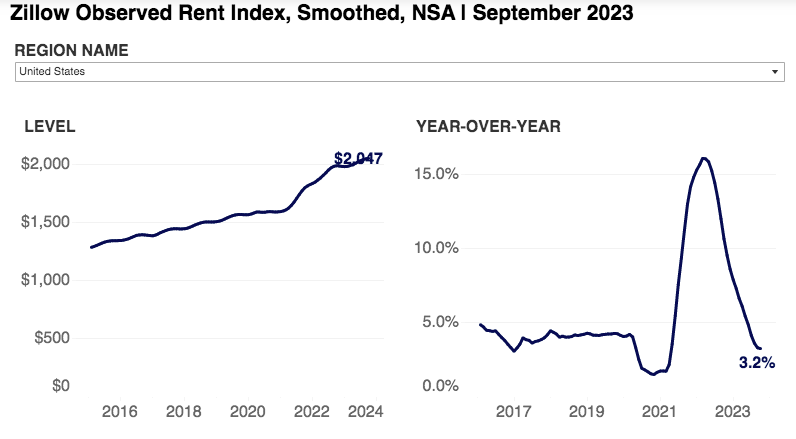Home values cooled in September, according to a new Zillow market report as housing competition eased faster than normal this fall as homebuyers grapple with the highest mortgage rates in more than 22 years.
"Mortgage rates approaching 8% are taking the wind out of the market's sails, pushing monthly mortgage payments beyond many buyers' budgets," said Jeff Tucker, Zillow Senior Economist. "While attractive listings are still moving at a brisk clip, competition among buyers is fading quickly due to the shock of mortgage rates on top of normal autumn seasonality."

Key Findings:
- Home values climbed month-over-month in 14 of the 50 largest metro areas in September, down from 32 last month. Gains were biggest in San Diego (0.8%), Miami (0.5%), Hartford (0.3%), Los Angeles (0.3%), and San Jose (0.3%).
- Home values fell, on a monthly basis, in 32 major metro areas, up from 12 last month. The largest monthly drops were in Austin (-1.4%), New Orleans (-1.4%), San Antonio (-0.9%), Portland (-0.6%), and Minneapolis (-0.6%).
- Home values are up from year-ago levels in more than half (31) of the 50 largest metro areas. Annual price gains are highest in Hartford (11.1%), Milwaukee (8.5%), Providence (6.4%), Virginia Beach (6.2%), and Philadelphia (6.1%).
- Home values are still down from year-ago levels in 18 major metro areas. The largest drops were in Austin (-10.0%), New Orleans (-8.8%), Las Vegas (-4.3%), Phoenix (-4.2%), and San Antonio (-2.5%).
Home values tick down
U.S. home values took a short step backward from August to September, falling 0.1%. That's not nearly as pronounced as the 0.8% monthly decline seen in September 2022, but a step backward is still unusual for this time of year. Between 2015 and 2019, monthly growth in September hovered between 0.1% and 0.4%.
The typical home value now stands at $350,091 nationally, up roughly 2% from this time last year. Of the 50 largest major metropolitan areas, 31 have home values higher than a year ago.
The strongest annual home value appreciation is in relatively affordable markets, led by Hartford (up 11.1%), Milwaukee (8.5%), Providence (6.4%), and Virginia Beach (6.2%). The largest declines are in pandemic-era hot spots Austin (-10%), Las Vegas (-4.3%), Phoenix (-4.2%), and San Antonio (-2.5%), as well as New Orleans (-8.8%).

A distinct lack of new inventory has troubled the market for more than a year. But some homeowners may not be able to delay sales any longer, potentially lessening the effect of "rate lock" on their decision. Rate lock refers to the incentive for existing homeowners not to sell because their existing mortgages have lower interest rates than today's prevailing rates.
Despite high and rising mortgage rates, the flow of new options for buyers is coming slightly closer in line with seasonal norms. Compared to 2019, new listings were down nearly 18% this September, an improvement over deficits of 20% in August and 27% in July.
New listings fell by about 6% from August to September, but the step down is usually bigger—monthly declines averaged 13% in 2018 and 2019.
The number of total listings for sale rose slightly in September, notching a 0.2% increase from August. But homebuyers still have far fewer choices than they normally would; inventory levels are about 10% lower than last year and 41% below those of 2019.
Competition eases as fall settles in
Home shoppers are getting a little more time to find and decide on a home, but attractive listings are still moving relatively quickly. The median time on the market before a listing goes pending is now 15 days—two days longer than in August. But that's still two days faster than last September and roughly half the time that shoppers enjoyed before the pandemic.
Home-buying conditions have continued to ease since late summer. Roughly 24% of listings in September received a price cut, a slight uptick from August and higher than 21% and 22% in 2018 and 2019, respectively.
Overall, rents are still climbing slowly. The rental market trends seem to be returning to normal, and September continued the normal seasonal trend of cooler growth in the second half of the year.
To read the full report, including more data, charts, and methodology, click here.

 DSNews The homepage of the servicing industry
DSNews The homepage of the servicing industry









